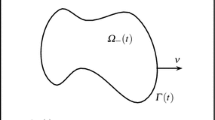Abstract
The global force-flow equations of nonequilibrium thermodynamics are obtained by solving the local equations of motion for a system ofn-components (n−1 solutes plus water) passing through a membrane. When viscous forces and position dependent membranepermeating species frictional interactions are considered, it becomes more difficult to obtain the result because even the stationary state problem becomes one of solving a second order linear ordinary differential equation for the barycentric velocity in a space divided inton+1 regions. Using the continuity of the boundary velocities and their gradients as well as the usual boundary conditions for the hydrodynamic problem, a set of 2n+1 linear equations in the intergration constants can be obtained and a closed form solution is possible. The resultant global description of the system does not obey Onsager reciprocity. What is more, the interpretation of global phenomenological coefficients in terms of local interactions in any simple way is next to impossible. This makes the hope of a molecular level interpretation of phenomenological membrane transport coefficients very slim. The relevance of this finding to the validity of reductionist approaches to biological transport is discussed.
Similar content being viewed by others
Literature
Anderson, J. L. and D. M. Malone. 1974. “Mechanism of Osmotic Flow in Porous Membranes.”Biophys. J.,14, 957–982.
Bearman, R. J. and J. G. Kirkwood. 1958. “The Statistical Mechanics of Transport Processes. XI Equations of Transport in Multi-component Systems.”J. Chem. Phys.,28, 136–145.
Brenner, H. and L. J. Gaydos. 1977. “The Constrained Brownian Movement of Spherical Particles in Cylindrical Pores of Comparable Radius: Models of the Diffusive and Convective Transport of Solute Molecultes in Membranes and Porous Media.”J. Colloid Interface Sci.,58, 312–356.
Bunow, B. J. and J. A. DeSimone. 1977. “How is Metabolic Energy Coupled into Active Transport?”Biophysics of Membrane Transport—Part II (Proceedings of the IVth Winter School) pp. 105–130. Wroclaw, Poland: Agricultural University of Wroclaw.
Daneshpajooh, M. H., E. A. Mason, E. H. Bressler and R. P. Wendt. 1975. “Equations for Membrane Transport. Experimental and Theoretical Tests of the Frictional Model.”Biophys. J.,15, 591–614.
Gary-Bobo, C. M. 1976. “Lateral Diffusion of Lipids in Phospholipid-water Lamellar System.”Biophysics of Membrane Transport—Part II (Proceedings of the Third Winter School) pp. 21–38. Wroclaw, Poland: Agricultural University of Wroclaw.
Ginzburg, B. Z. and A. Katchalsky. 1963. “The Frictional Coefficients of the Flows of Nonelectrolytes Through Artificial Membranes.”J. Gen. Physiol.,47, 403–418.
Iberall, A. and A. Schindler. 1973.Physics of Membrane Transport. Upper Darby, PA: General Technical Services, Inc.
Katchalsky, A. and P. F. Curran. 1965.Nonequilibrium Thermodynamics in Biophysics. Cambridge, MA: Harvard University Press.
Kedem, O. and A. Katchalsky. 1961. “A Physical Interpretation of the Phenomenological Coefficients of Membrane Permeability.”J. Gen. Physiol.,45, 143–179.
— 1963a. “Permeability of Composite Membranes.—Electric Current, Volume Flow and Flow of Solute through Membranes.”Trans. Faraday Soc.,59, 1918–1953. 1.
— 1963b. “II. Parallel Elements.”——ibid.,59, 1931–1940.
— 1963c. “III. Series Array of Elements.”——ibid.,59, 1941–1953.
Koestler, A. and J. R. Smythies (Eds.). 1969.Beyond Reductionism: New Prespectives in the Life Sciences. Boston, Mass: Beacon Press.
Lange, V. and C. M. Gary-Bobo. 1974. “Ion Diffusion in Lecithin-Water Lamellar Phases.”Nature New Biol.,246, 150–151.
Levitt, D. G. 1975. “General Continuum Analysis of Transport Through Pores. I. Proof of Onsager's Reciprocity Postulate for Uniform Pore.”Biophys. J.,15, 533–552.
Manning, G. S. 1974. “The Use of Molecular Models in the Analysis of the Phenomenological Coefficients of Flow Through Membranes.”Biophysics of Membrane Transport-Part II. (Proceedings of the First Winter School) pp. 216–237. Wroclaw, Poland: Agricultural Institute of Wroclaw.
Mikulecky, D. C. and S. R. Caplan. 1966. “The Choice of Reference Frame the Treatment of Membrane Transport by Nonequilibrium Thermodynamics.”J. Phys. Chem.,70, 3049–3056.
Mikulecky, D. C. 1968. “On the Relative Contribution of Viscous Flow vs Diffusional (Frictional) Flow to the Stationary State Flow of Water Through a ‘Tight’ Membrane.”Biophys. J.,7, 527–534.
— 1994. “The Use of Continuum Mechanics and the New Network Thermodynamics in the Theory of Membrane Transport: I. A Continuum Mechanical Approach to the Flow Equations of Nonequilibrium Thermodynamics.”Biophysics of Membrane Transport—Part I (Proceedings of the First Winter School). pp. 120–155. Wroclaw, Poland: Agricultural Institute of Wroclaw.
— 1976. “Viscous Flow and Minimum Dissipation in Biological Membranes.”Biophysics of Membrane Transport (Proceedings of the Third Winter School). pp. 5–20. Wroclaw, Poland: Agricultural Institute of Wroclaw.
— 1977. “A Simple Network Thermodynamic Method for Series Parallel Coupled Flows: II The Nonlinear Theory, with Applications to Coupled Solute and Volume Flow in a Series Membrane.”Biophysics of Membrane Transport (Proceedings of the Fourth Winter School). pp. 31–74. Wroclaw, Poland: Agricultural Institute of Wroclaw. AlsoJ. Theor. Biol.,69: 511–540.
—, W. A. Thedford and J. A. DeSimone. 1977. “Local vs Global Reciprocity and an Analysis of the Teorell Membrane Oscillator Using Catastrophe Theory: Part I—Reciprocity and Bifurcation.”Biophysics of Membrane Transport (Proceedings of the Fourth Winter School). pp. 75–118. Wroclaw, Poland: Agricultural Institute of Wroclaw.
Mikulecky, D. C. 1978a. “Global Flow Equations for Membrane Transport from Local Equations of Motion: II The Case of a Single Nonelectrolyte Solute Plus Water.”Bull. Math. Biol. (in press).
Mikulecky, D. C. and Gary-Bobo. 1978b. “A Determination of Membrane-solute and Membrane-water Position-dependent Friction Coefficients from Experiments on Lecithin Lamellar Structures.” (in preparation).
Rigaud, J. L., C. M. Gary-Bobo and Y. Lange. 1972. “Diffusion Processes in Lipid-Water Lamellar Phases.”Biochim. Biophys. Acta,266, 72–84.
Rosen R. 1968. “Some Comments on the Physico-chemical Description of Biological Activity.”J. Theor. Biol.,18, 380–386.
Snell, F. M., R. Aranow and R. A. Spangler. 1967. “Statistical-Mechanical Derivation of the Partial Molecular Stress Tensors in Isothermal Multicomponent Systems.”J. Chem. Phys.,47, 4959–4971.
Snell, F. M. and R. A. Spangler. 1967. “A Phenomenological Theory of Transport in Multicomponent Systems.”J. Phys. Chem.,71, 2503–2510.
Soo, S. L. 1967.Fluid Dynamics of Multiphase Systems. Waltham, Mass: Blaisdell.
Vaidhyanathan, V. S., W. H. Perkins and E. J. Towbin. 1964. “Theory of Transport Across a Membrane Model.”J. Theor. Biol.,7, 339–351.
Author information
Authors and Affiliations
Rights and permissions
About this article
Cite this article
Mikulecky, D.C. Global flow equations for membrane transport from local equations of motion: I. The general case for (n−1) nonelectrolyte solutes plus water. Bltn Mathcal Biology 40, 791–805 (1978). https://doi.org/10.1007/BF02460607
Received:
Revised:
Issue Date:
DOI: https://doi.org/10.1007/BF02460607




